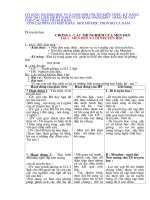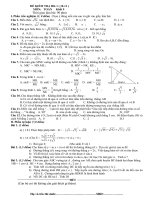Bài giảng MARKETING MANAGEMENT LECTURE NOTES: Chapter 9 marketing channels
Bạn đang xem bản rút gọn của tài liệu. Xem và tải ngay bản đầy đủ của tài liệu tại đây (296.48 KB, 7 trang )
3/8/2018
Phillip
Kevin Lane
Kotler • Keller
Marketing Management • 14e
Chapter 9
Chapter Eight
Marketing Channels
Delivering Customer Value
Marketing Channels
Delivering Customer Value
Copyright © 2010 Pearson Education, Inc.
Publishing as Prentice Hall
Chapter 12 - slide 1
Copyright © 2009 Pearson Education, Inc.
Publishing as Prentice Hall
Marketing Channels
Delivering Customer Value
Topic Outline
• Supply Chains and the Value Delivery Network
• The Nature and Importance of Marketing
Channels
• Channel Behavior and Organization
• Channel Design Decisions
• Channel Management Decisions
• Marketing Logistics and Supply Chain
Management
Copyright © 2010 Pearson Education, Inc.
Publishing as Prentice Hall
Chapter 12 - slide 3
Supply Chain Partners
The supply chain consists of two types of
partners:
Upstream partners include raw material
suppliers, components, parts, information,
finances, and expertise to create a product
or service
Downstream partners include the marketing
channels or distribution channels that look
toward the customer
Copyright © 2010 Pearson Education, Inc.
Publishing as Prentice Hall
WHAT IS DISTRIBUTION?
PRODUCT
MANUFACT
URER
Chapter 12 - slide 4
WHAT IS DISTRIBUTION CHANNEL?
CONSUMER
PRODUCT
Trader
Copyright © 2010 Pearson Education, Inc.
Publishing as Prentice Hall
Chapter 12 - slide 2
Chapter 12 - slide 5
Copyright © 2010 Pearson Education, Inc.
Publishing as Prentice Hall
DISTRIBUTI
ON
CHANNEL
Representa
tive
CONSUMER
Connection
service
provider
Chapter 12 - slide 6
1
3/8/2018
DISTRIBUTION CHANNEL’S FUCTION
COLLECT &
ADJUST
PRODUCT
SUPPLY
PRODUCT
SUPPORT
CUSTOMER
The Nature and Importance of
Marketing Channels
How Channel Members Add Value
STORAGE &
TRANSPORT
Information
Promotion
Contact
Matching
Negotiation
Physical
distribution
COLLECT
CUSTOMER’S
FEEDBACKS
Financing
Copyright © 2010 Pearson Education, Inc.
Publishing as Prentice Hall
Chapter 12 - slide 7
Risk Taking
Copyright © 2010 Pearson Education, Inc.
Publishing as Prentice Hall
Chapter 12 - slide 8
Channel Behavior and
Organization
Channel Behavior and
Organization
Channel Behavior
Conventional Distributions Systems
Marketing channel consists of firms that have
partnered for their common good with each
member playing a specialized role
Conventional distribution systems consist
of one or more independent producers,
wholesalers, and retailers.
Each seeks to maximize its own profits, and
there is little control over the other members
and no formal means for assigning roles and
resolving conflict.
Channel conflict refers to disagreement over
goals, roles, and rewards by channel
members
• Horizontal conflict
• Vertical conflict
Copyright © 2010 Pearson Education, Inc.
Publishing as Prentice Hall
Chapter 12 - slide 9
Copyright © 2010 Pearson Education, Inc.
Publishing as Prentice Hall
RETAIL DISTRIBUTION CHANNEL
LEVELS OF DISTRIBUTION CHANNEL
Manufact
urer
INDIRECT
CHANNEL
DIRECT
CHANNEL
DISTRIBUTION
CHANNEL
customer
Copyright © 2010 Pearson Education, Inc.
Publishing as Prentice Hall
Chapter 12 - slide 11
Manufact
urer
Manufact
urer
Represe
ntative
INDIRECT
CHANNEL
Manufact
urer
DIRECT
CHANNEL
Chapter 12 - slide 10
Wholesal
er
Wholesal
er
Retailer
Retailer
Retailer
custom
customer
er
custom
customer
er
customer
Copyright © 2010 Pearson Education, Inc.
Publishing as Prentice Hall
Chapter 12 - slide 12
2
3/8/2018
Channel Behavior and
Organization
DISTRIBUTION CHANNEL TYPES
Vertical Marketing Systems
DISTRIBUTION
CHANNEL
VERTICAL
DISTRIBUTION
CHANNEL
HORIZONTAL
DISTRIBUTION
CHANNEL
Copyright © 2010 Pearson Education, Inc.
Publishing as Prentice Hall
MULTI
DISTRIBUTION
CHANNEL
Chapter 12 - slide 13
•
•
•
Vertical marketing systems (VMS) provide
channel leadership and consist of producers,
wholesalers, and retailers acting as a unified
system and consist of:
Corporate marketing systems
Administered marketing systems
Contractual marketing systems
Copyright © 2010 Pearson Education, Inc.
Publishing as Prentice Hall
Chapter 12 - slide 14
VERTICAL MARKETING SYSTEM (VMS)
VERTICAL MARKETING SYSTEM
Wholesaler
Manufacturer
Manufacturer
Vertical
marketing
system (VMS)
Corporate
marketing
systems
Administered
marketing
systems
Conventional
Distributions
Systems
Contractual
marketing
systems
Wholesaler
Retailer
Customer
Copyright © 2010 Pearson Education, Inc.
Publishing as Prentice Hall
Chapter 12 - slide 15
CORPORATE MARKETING SYSTEMS
Corporate vertical
marketing system
integrates
successive stages of
production and
distribution under
single ownership
Copyright © 2010 Pearson Education, Inc.
Publishing as Prentice Hall
Copyright © 2010 Pearson Education, Inc.
Publishing as Prentice Hall
Retailer
VERTICAL
MARKETING
SYSTEM - VMS
Customer
Chapter 12 - slide 16
ADMINISTERED VERTICAL MARKETING SYSTEM
Administered vertical
marketing system has
a few dominant
channel members
without common
ownership. Leadership
comes from size and
power
Chapter 12 - slide 17
Copyright © 2010 Pearson Education, Inc.
Publishing as Prentice Hall
Chapter 12 - slide 18
3
3/8/2018
CONTRACTUAL MARKETING SYSTEMS
HỆ THỐNG PHÂN PHỐI LIÊN KẾT NGANG
CONTRACTUAL
MARKETING SYSTEMS
Horizontal marketing systems are when
two or more companies at one level join
together to follow a new marketing
opportunity. Companies combine financial,
production, or marketing resources to
accomplish more than any one company
could alone.
A network in which
cooperation and
coordination are
formally agreed,
indicating the
responsibilities and
commitments of each
member of the
network.
Copyright © 2010 Pearson Education, Inc.
Publishing as Prentice Hall
Chapter 12 - slide 19
Copyright © 2010 Pearson Education, Inc.
Publishing as Prentice Hall
Channel Behavior and
Organization
MULTI DISTRIBUTION CHANNEL
Manufacturer
Multichannel Distribution Systems
Hybrid Marketing Channels
Multichannel Distribution systems
(Hybrid marketing channels) are when a
single firm sets up two or more marketing
channels to reach one or more customer
segments
Chapter 12 - slide 21
DISTRIBUT
OR
CATALOGUE,
TELESALES ,
INTERNET
SEGMENTATION
1
Copyright © 2010 Pearson Education, Inc.
Publishing as Prentice Hall
Chapter 12 - slide 20
PERSONAL
SELLER
RETAILER
WHOLESAL
ER
SEGMENTATION
2
SEGMENTATION
3
Copyright © 2010 Pearson Education, Inc.
Publishing as Prentice Hall
SEGMENTATION 4
Chapter 12 - slide 22
Channel Design Decisions
Channel Design Decisions
Setting Channel Objectives
Analyzing
consumer
needs
Setting
channel
objectives
Identifying
major
channel
alternatives
Evaluation
Copyright © 2010 Pearson Education, Inc.
Publishing as Prentice Hall
•
•
•
•
Chapter 12 - slide 23
Targeted levels of customer service
What segments to serve
Best channels to use
Minimizing the cost of meeting customer
service requirements
Copyright © 2010 Pearson Education, Inc.
Publishing as Prentice Hall
Chapter 12 - slide 24
4
3/8/2018
Channel Design Decisions
Channel Design Decisions
Identifying Major Alternatives
Identifying Major Alternatives
• Types of intermediaries
• Number of intermediaries
• Responsibilities of each channel
member
Intensive distribution
• Candy and toothpaste
Exclusive distribution
• Luxury automobiles and prestige
clothing
Selective distribution
• Television and home appliance
Copyright © 2010 Pearson Education, Inc.
Publishing as Prentice Hall
Chapter 12 - slide 25
Channel Design Decisions
Evaluating the Major Alternatives
• Each alternative should be evaluated
against:
• Economic criteria
• Control
• Adaptive criteria
Copyright © 2010 Pearson Education, Inc.
Publishing as Prentice Hall
Chapter 12 - slide 27
Channel Management Decisions
Selecting
channel
members
Managing
channel
members
Copyright © 2010 Pearson Education, Inc.
Publishing as Prentice Hall
Motivating
channel
members
Evaluating
channel
members
Chapter 12 - slide 29
Copyright © 2010 Pearson Education, Inc.
Publishing as Prentice Hall
Chapter 12 - slide 26
Channel Design Decisions
Designing International Distribution Channels
• Channel systems can vary from country
to country
• Must be able to adapt channel
strategies to the existing structures
within each country
Copyright © 2010 Pearson Education, Inc.
Publishing as Prentice Hall
Chapter 12 - slide 28
Public Policy and Distribution
Decisions
Exclusive distribution is when the seller
allows only certain outlets to carry its
products
Exclusive dealing is when the seller requires
that the sellers not handle competitor’s
products
Exclusive territorial agreements is when
producer or seller limit territory
Tying agreements are agreements where the
dealer must take most or all of the line
Copyright © 2010 Pearson Education, Inc.
Publishing as Prentice Hall
Chapter 12 - slide 30
5
3/8/2018
Marketing Logistics and
Supply Chain Management
Marketing Logistics and
Supply Chain Management
Nature and Importance of Marketing
Logistics
Nature and Importance of Marketing
Logistics
Marketing logistics (physical distribution)
involves planning, implementing, and
controlling the physical flow of goods,
services, and related information from points
of origin to points of consumption to meet
consumer requirements at a profit
Copyright © 2010 Pearson Education, Inc.
Publishing as Prentice Hall
Chapter 12 - slide 31
Supply chain management is the process of
managing upstream and downstream valueadded flows of materials, final goods, and
related information among suppliers, the
company, resellers, and final consumers
Copyright © 2010 Pearson Education, Inc.
Publishing as Prentice Hall
Marketing Logistics and
Supply Chain Management
Marketing Logistics and
Supply Chain Management
Major Logistics Functions
Warehousing
Inventory
management
Transportation
Logistics
information
management
Copyright © 2010 Pearson Education, Inc.
Publishing as Prentice Hall
Chapter 12 - slide 33
Marketing Logistics and Supply
Chain Management
Inventory Management
• Just-in-time systems
• RFID
Chapter 12 - slide 32
Warehousing Decisions
•
•
•
•
How many
What types
Location
Distribution centers
Copyright © 2010 Pearson Education, Inc.
Publishing as Prentice Hall
Chapter 12 - slide 34
Marketing Logistics and
Supply Chain Management
Major Logistics Functions
Transportation affects the pricing of products,
delivery performance, and condition of the
goods when they arrive
– Knowing exact product location
• Smart shelves
Truck
Rail
Water
Pipeline
Air
Internet
– Placing orders automatically
Copyright © 2010 Pearson Education, Inc.
Publishing as Prentice Hall
Chapter 12 - slide 35
Copyright © 2010 Pearson Education, Inc.
Publishing as Prentice Hall
Chapter 12 - slide 36
6
3/8/2018
Marketing Logistics and
Supply Chain Management
Marketing Logistics and
Supply Chain Management
Logistics Information Management
Integrated Logistics Management
Logistics information management is the
management of the flow of information,
including customer orders, billing, inventory
levels, and customer data
• EDI (electronic data interchange)
• VMI (vendor-managed inventory)
Integrated logistics management is the
recognition that providing customer service
and trimming distribution costs requires
teamwork internally and externally
• Cross-functional teamwork inside the
company
• Building partner relationships
Copyright © 2010 Pearson Education, Inc.
Publishing as Prentice Hall
Chapter 12 - slide 37
Copyright © 2010 Pearson Education, Inc.
Publishing as Prentice Hall
Chapter 12 - slide 38
Marketing Logistics and
Supply Chain Management
Integrated Logistics Management
Third-party logistics is the outsourcing of
logistics functions to third-party logistics
providers (3PLs)
Copyright © 2010 Pearson Education, Inc.
Publishing as Prentice Hall
Chapter 12 - slide 39
7









